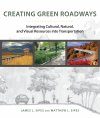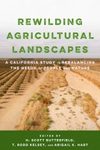About this book
In Creating Green Roadways, James and Matthew Sipes demonstrate that roads don't have to be the enemy of sustainability: they can be designed to minimally impact the environment while improving quality of life. The authors examine traditional, utilitarian methods of transportation planning that have resulted in a host of negative impacts: from urban sprawl and congestion to loss of community identity and excess air and water pollution.
They offer a better approach – one that blends form and function. Through case studies and photos from around the country, Creating Green Roadways provides an examination of all aspects of green roads, from transportation policy to the basics of road design, public involvement, road ecology, and the economics of sustainable roads. This comprehensive guide offers a practical strategy for rethinking how we design, plan, and maintain our transportation infrastructure.
Contents
Chapter 1. Introduction
-Why We Need Green Roadways
-The Expansion of Our Highway Infrastructure
-The Problem
-Green Roadways and Quality of Life
-Overview of the Book
Chapter 2. Transportation Policies
-Federal Policies and Procedures
-Federal Acts and Regulations
-NEPA
-State and Local Policies and Procedures
Chapter 3. Basic Roadway Design
-Road Types
-Access Control
-Types of Transportation Projects
-Sources of Basic Transportation Standards
-Impact of Design Speeds and Level of Service on Roadway Design
-Importance of Safety
-Design Exceptions
-Right-of-Way
-Greening Roadway Components
-Pedestrian Facilities
-Art
-Summary
Chapter 4. Design and Planning Process for Green Roadways
-Overview of the Process of Planning and Designing a Green Road
-Environmental Considerations in Planning
-Transportation Planning
-Rethinking Roads: Context-Sensitive Design/Context-Sensitive Solutions
-Planning to Reduce Risks Associated with Green Roadways
-Land Use Planning, Smart Growth, Complete Streets, and Transportation Infrastructure
-Road Diets
-Transit-Oriented Development and Highway Interchange Transit-Oriented Development
-Highway Corridor Overlay District
-Value Engineering
-Transportation Challenges
-Problems with Current Mass Transit
-Rising Interest
Chapter 5. Public Involvement Process
-Public Involvement Begins at the Beginning
-Public Involvement Plan
-Social Media and Public Involvement
-Visualization
-Partnership Opportunities for Green Roadways
-Case Study: Public Participation
1. Vancouver Land Bridge, Vancouver, Washington
Chapter 6. Green Roadways in Urban Areas
-Deemphasizing Roads
-Retrofitting Existing Streets
-New Transportation Projects
-Urban Case Studies
1. Mexicantown Bagley Avenue Pedestrian Bridge and Plaza, Detroit, Michigan
2. Boston’s Big Dig
5. Portland’s Green Streets Program
4. Multifunction Roundabout, Normal, Illinois
5. Delaware Avenue Expansion, Philadelphia, Pennsylvania
6. T-REX Light-Rail Pedestrian Bridge, Denver, Colorado
-Summary
Chapter 7. Green Roadways in Rural and Suburban Areas
-Rural Transportation
-Types of Rural Development
-The Suburbs
-Livable, Walkable Communities
-Suburban and Rural Case Studies
1. The Rain Gardens of Maplewood, Minnesota
2. State Route 17 in Horseheads, New York
3. High Point Redevelopment, Seattle, Washington
Chapter 8. Cultural/Historic/Visual Resources
-Cultural and Historic Resources
-Archaeology
-Visual Resources
-Approaches for Addressing Visual Resources
-Design Approaches
-Road Layout
-Landform
-Scenic Byways
-Case Studies: Cultural/Historic/Visual Resources in Transportation
1. I-70 Glenwood Canyon and Snowmass Canyon, Colorado
2. Paris Pike, Kentucky
3. Old Florida Heritage Highway, Florida
4. Merritt Parkway, Connecticut
5. Nevada Landscape and Aesthetics Master Plan
6. Blue Ridge Parkway, Virginia and North Carolina
7. Natchez Trace Parkway Bridge, Tennessee
8. Creative Corridors, Winston-Salem, North Carolina
Chapter 9. Natural Resources/Environmental Sustainability
-Wildlife Habitat
-Road Ecology
-Wildlife Crossings
-Habitat Alterations
-Planning for Climate Change
-Open Space Opportunities
-Protecting Open Space
-Water Resources
-Air Quality
-Energy Conservation
-Generating Energy
-Case Studies: Integrating Natural Resources and Green Roads
1. Corridor K, Cherokee National Forest, Tennessee
2. US Highway 93, Montana
3. Alligator Alley, Florida
4. Mountains to Sound Greenway, Washington
5. Yellowstone National Park’s East Entrance Road
6. ARC International Design Competition for Wildlife Crossing Infrastructure, Vail Pass, Colorado
Chapter 10. Constructing Green Roadways
-Green Construction Practices
-Green Construction Materials
-Recycling
-Case Studies: Green Construction
1. New River Gorge Bridge, West Virginia
2. Meador Kansas Ellis Trail, Washington State
3. US 97 Lava Butte-South Century Drive, Oregon
Chapter 11. Economics of Green Roadways
-Funding Road Infrastructure
-Funding Green Roadways
-Increasing Efficiency
-Maintenance and Life-Cycle Costs
-Case Studies: Economics of Green Roadways
1. Atlanta BeltLine, Georgia
2. Greater East End Livable Centers, Houston, Texas
Chapter 12. Next Steps in Creating Green Roadways
-Planning for Green Roadways
-Changing the Emphasis of Transportation Funding
-Measuring Success for Green Roadways
-Sustainable Highways
-Measuring Success for Green Roadways
-U.S. Case Studies—Next Steps
1. Manchaca Greenway, Austin, Texas
2. Oregon Solar Highway
3. Houston Low Impact Development–Independence Parkway, Texas
-International Case Studies
1. Henderson Waves Bridge, Singapore
2. Clem Jones Tunnel, Brisbane, Australia
3. Zaragoza Bridge Pavilion, Zaragoza, Spain
4. Atlantic Road Bridge, Norway
5. City of Saskatoon (Canada) Green Streets Program
-Summary
Appendix 1. Resource Characteristics
Selected Resources
Index
Customer Reviews
Biography
James L. Sipes is a landscape architect, environmental planner, and the author of Digital Land and Sustainable Solutions to Water Resources. Matthew L. Sipes is a civil engineer with HMB Professional Engineers, Inc.


































